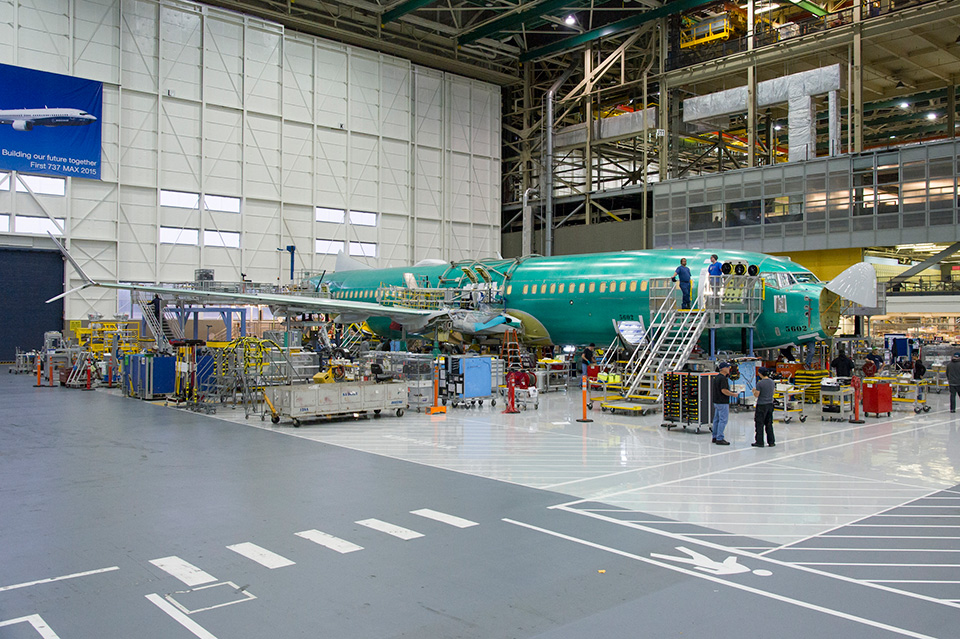Leeham News and Analysis
There's more to real news than a news release.
Bjorn’s Corner: Engine efficiency
 18 September 2015, ©. Leeham Co: The debate around the market’s two single aisle combatants is quite heated, with fans of the one side saying “the limited space for a high bypass engine on the 737 MAX will cripple it forever” and the other side saying “the tighter design of the 737 will make it highly competitive against the A320neo, it is the A320 which has a weight and size problem”.
18 September 2015, ©. Leeham Co: The debate around the market’s two single aisle combatants is quite heated, with fans of the one side saying “the limited space for a high bypass engine on the 737 MAX will cripple it forever” and the other side saying “the tighter design of the 737 will make it highly competitive against the A320neo, it is the A320 which has a weight and size problem”.
One of the arguments is that each inch of engine fan diameter brings 0.5% in increased propulsive efficiency. Therefore the A320 with up to 81 inches fans will win against the 737 MAX, which has a 69 inch fan. Having all the tools to check out if this is really the truth, I fed our airplane model with all the facts and looked at the result. It’s not so easy, guys…
A320 FAL “good for US aerospace,” says Airbus
Sept. 16, 2015, © Leeham Co., Mobile (AL): The opening of the Airbus A320 Final Assembly Line here achieves a major set of goals set by the company 10 years ago for its own strategic purposes, but officials are also mindful of the larger impact on US aerospace.
achieves a major set of goals set by the company 10 years ago for its own strategic purposes, but officials are also mindful of the larger impact on US aerospace.

David L. Williams, VP Procurement, Airbus Americas. Photo via Google images.
Top executives point out that the Mobile plant reestablished a second commercial aviation assembly site in the US since the last MD-11s and MD-95s rolled out of the former McDonnell Douglas plant in Long Beach (CA) after its acquisition by The Boeing Co in 1997. Boeing continued production of the MD-11 until the end of 2000 (with deliveries occurring in 1Q2001). The last MD-95, renamed the Boeing 717, was produced in 2006. There were 200 MD-11s and 156 717s produced.
With nearly 10 years elapsing between that last 717 and the first A321ceo coming out of Mobile, Airbus officials say the creation of the FAL is not only good for Airbus and Alabama, it’s good for US aerospace.
Boeing’s 767 revitalized as a MOM stop gap, Part 2
By Bjorn Fehrm
Subscription required.
Introduction
Aug. 31 2015, ©. Leeham Co: Last week we started to look at Boeing’s 767 to see if it can serve the passenger and range space which is not well covered by modern aircraft: the 225 passenger/5,000nm sector. Boeing calls this the Middle of the Market or MOM. Boeing recently said that there is some increased interest for the 767. We analyze why and what can be done to increase any chances of it having a new life as a passenger aircraft.
We started with comparing the 767’s different variants to the most likely MOM aircraft from our series “Redefining the 757 replacement requirement for the 225/5000-sector”. We will now continue and look at the 767 in detail, its strong suits and its less efficient areas. We will also discuss what can be made to address the less efficient areas.
Summary:
- Boeing’s 767 has the right cross section for passenger transportation in the 225 passenger/5,000nm segment.
- It also carries cargo containers, not as efficiently this time. We show what the consequences are.
- Finally the wing is not the slender wing of the modern aircraft. We show what impact it will have on overall efficiency.
- Combined with engines from the 1990s, this gives less than stellar fuel economics. We investigate what can be done about this and how much of an impact it will have in today’s low fuel prices.
Rolls-Royce and Safran, major European engine OEMs with different fortunes.
By Bjorn Fehrm
Subscription required.
July 30, 2015 © Leeham Co. Rolls-Royce and Safran, the parent company of CFM partner Snecma, released their Q2 and first half 2015 earnings today. It is interesting to compare these companies as they are in different strategic situations in their dominant business segments, civil turbofan engines.
Civil turbofans constitute 52% of Rolls-Royce total business whereas it makes 54% of Safran’s turn over. Rolls-Royce’s focus has been widebody engines to the point where it exited its part of International Aero Engines, which makes the single aisle V2500 engine, three years ago. Safran on the other hand is heavily invested in the single aisle market through its 50% part in CFM through its Snecma subsidiary.
The present situation and the future outlook for these two companies are intimately aligned with this strategic difference. We look at why and how this will affect their immediate future.
Summary:
- Rolls-Royce is experiencing migration problems in its widebody turbofan business. Its bread and butter Trent 700 engine is on its way out and it takes until 2018 for the replacement, Trent 7000, to kick in.
- Other programs are only growing slowly: the Trent 1000 for Boeing’s 787 or Trent XWB for the Airbus A350.
- Safran civil turbofan business Snecma is enjoying record sales and deliveries through its CFM joint venture with GE.
- Despite sharing its revenue 50:50 with GE, the business turnover is the size of Rolls-Royce turbofan business today and larger tomorrow. Profit margins are three times higher.




Airbus ‘confident’ engine makers can ramp up production
Subscription Required
Introduction
CFM makes about 50% of the engines on the A320 Family and has about 50% of the backlog for the New
Tom Enders, CEO of Airbus Group. Airbus photo.
Engine Option version. Pratt & Whitney has about the same market share for the NEO, depending on what month it is, with a large number of orders for which no engine has been selected.
Airbus and Boeing are each studying whether to ramp up production of the A320 and 737 families above the record rates already planned.
In an interview Sunday with Leeham News and Comment in advance of the A320 Final Assembly Line opening here, Enders said studies continue whether to take A320 production rates to 60 a month. Boeing is studying rates of 60-63 a month.
Summary
Read more
Leave a Comment
Posted on September 17, 2015 by Scott Hamilton
Airbus, Boeing, CFM, Leeham News and Comment, Pratt & Whitney, Premium
737 MAX, A320NEO, A380, A400M, air force tanker, Airbus, Airbus Group, Boeing, CFM, Fabrice Bregier, John Leahy, KC-46A, KC-X, Pratt & Whitney, SkyMark, Tom Enders, Transaero, USAF, Virgin Atlantic Airways